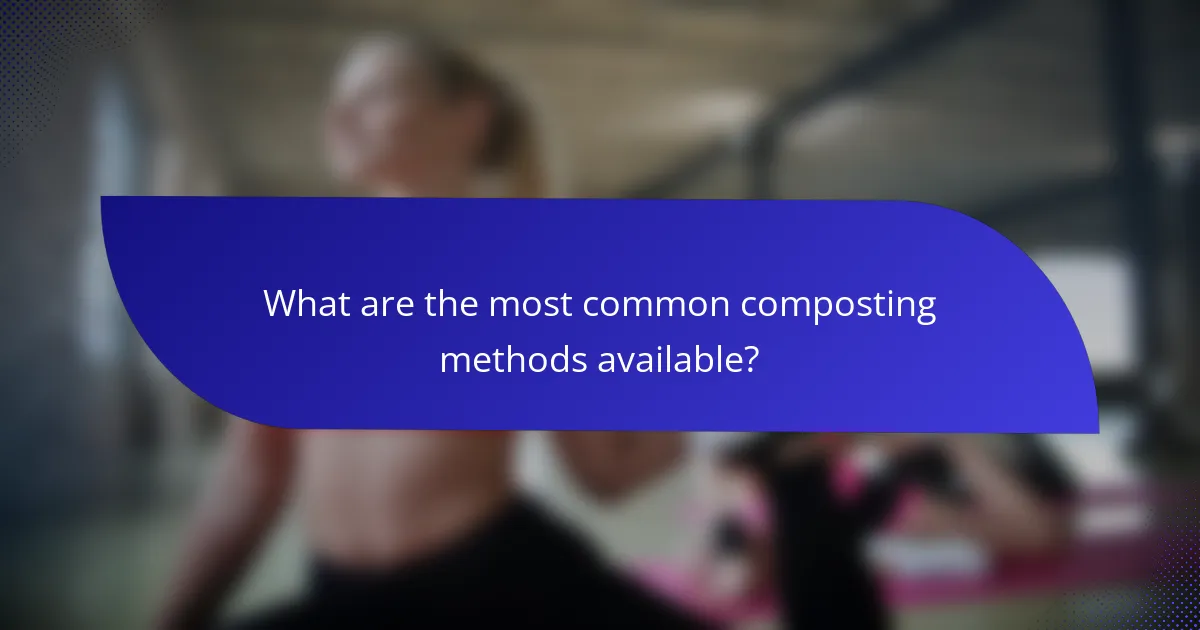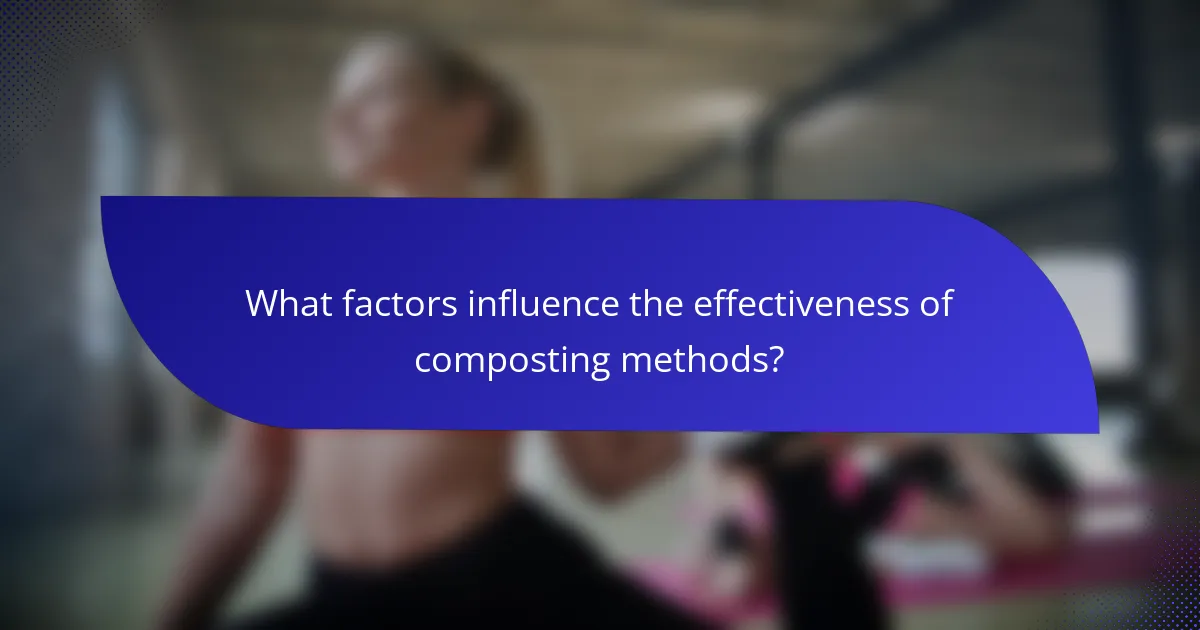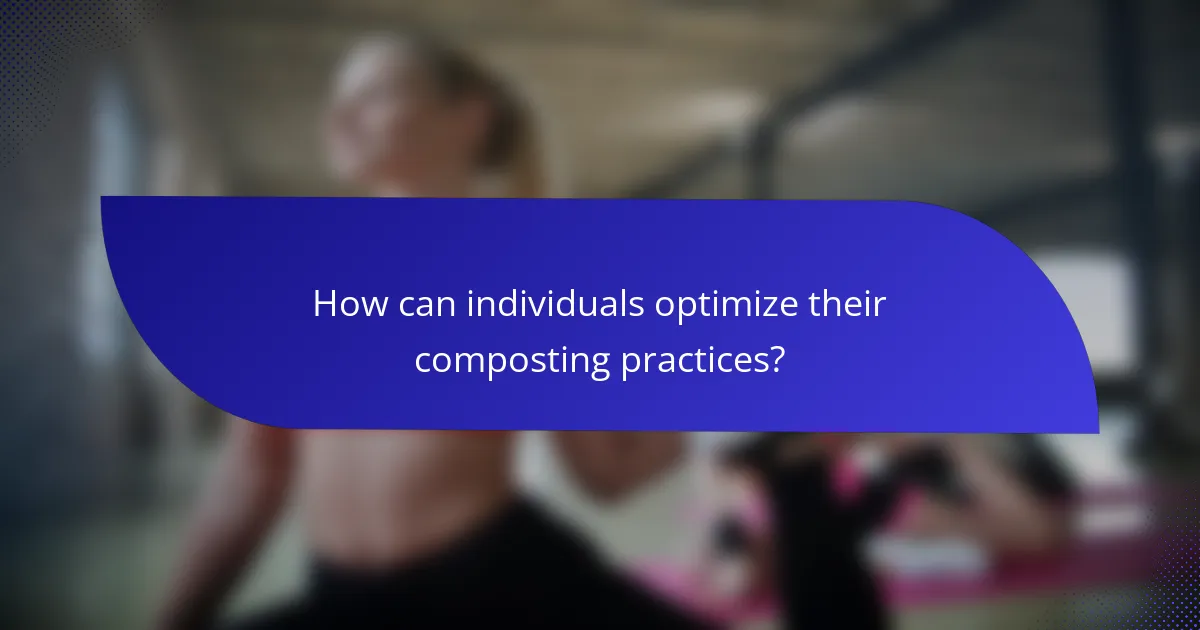Composting methods provide a sustainable solution for managing organic waste while enriching soil and reducing landfill contributions. This article explores various techniques such as backyard composting, vermicomposting, bokashi composting, and trench composting. It also addresses factors affecting composting effectiveness, challenges faced, and innovative technologies enhancing the process. Understanding these aspects can help individuals adopt eco-friendly waste management practices effectively.

What are the key benefits of composting methods for eco-friendly waste management?
Composting methods offer significant benefits for eco-friendly waste management. They reduce landfill waste, enrich soil, conserve water, and lower greenhouse gas emissions.
These methods transform organic waste into nutrient-rich compost, enhancing soil fertility and structure. For instance, composting can improve soil moisture retention by up to 30%. This process not only promotes healthy plant growth but also minimizes the need for chemical fertilizers.
Additionally, composting reduces methane emissions from landfills, contributing to climate change mitigation. It serves as a sustainable alternative to traditional waste disposal, fostering a circular economy by recycling nutrients back into the ecosystem.
How does composting reduce landfill waste and greenhouse gas emissions?
Composting significantly reduces landfill waste and greenhouse gas emissions by transforming organic materials into nutrient-rich soil. This process diverts waste from landfills, decreasing the volume of refuse that contributes to methane emissions. Additionally, composting enhances soil health, which can further mitigate carbon dioxide levels in the atmosphere. By incorporating composting into waste management practices, communities can effectively lower their environmental footprint.
Which nutrients are enriched in soil through composting?
Composting enriches soil primarily with nitrogen, phosphorus, potassium, calcium, and magnesium. These nutrients enhance soil fertility and promote healthy plant growth. Compost also improves soil structure, moisture retention, and microbial activity, creating a balanced ecosystem.
Why is composting beneficial for local ecosystems?
Composting benefits local ecosystems by enhancing soil health, promoting biodiversity, and reducing waste. It enriches soil with nutrients, leading to healthier plants and improved water retention. This process supports various organisms, such as earthworms and beneficial microbes, which play crucial roles in nutrient cycling. Additionally, composting decreases landfill waste, minimizing methane emissions and fostering a sustainable environment.

What are the most common composting methods available?
The most common composting methods include backyard composting, vermicomposting, bokashi composting, and trench composting. Each method offers unique benefits for eco-friendly waste management.
Backyard composting involves combining kitchen scraps and yard waste in a compost bin, creating nutrient-rich soil over time. Vermicomposting uses worms to break down organic material, producing high-quality fertilizer. Bokashi composting utilizes fermentation to process food waste, making it suitable for indoor use. Trench composting entails burying organic waste in the ground, allowing natural decomposition to occur.
These methods cater to different preferences and available space, promoting sustainable practices in waste management.
How does traditional composting work?
Traditional composting works by breaking down organic waste through natural processes involving microorganisms. This method typically requires a balance of carbon-rich materials, such as dry leaves and straw, and nitrogen-rich materials, like kitchen scraps and grass clippings.
The composting process consists of several stages:
1. **Collection**: Gather organic waste materials.
2. **Layering**: Alternate layers of carbon and nitrogen materials.
3. **Aeration**: Turn the pile regularly to provide oxygen.
4. **Moisture**: Maintain adequate moisture levels for microbial activity.
5. **Decomposition**: Over weeks to months, microorganisms break down the materials into nutrient-rich compost.
The final product is a dark, crumbly substance that enriches soil, showcasing the unique attribute of transforming waste into a valuable resource.
What is vermicomposting and how does it differ from traditional methods?
Vermicomposting uses worms to decompose organic waste, while traditional composting relies on microorganisms. Vermicomposting is faster, producing nutrient-rich castings in weeks compared to months for traditional methods. Additionally, vermicomposting requires less space and can be done indoors, making it a unique option for urban environments. Traditional composting often involves larger piles and more complex management.
Which benefits do aerobic and anaerobic composting offer?
Aerobic and anaerobic composting offer distinct benefits for eco-friendly waste management. Aerobic composting promotes faster decomposition, reducing waste volume significantly within weeks. It enhances nutrient availability in soil, improving plant growth. Anaerobic composting, while slower, produces biogas, a renewable energy source, and reduces greenhouse gas emissions. Both methods contribute to sustainable practices by recycling organic waste and enriching soil health.
How does Bokashi composting work and what are its advantages?
Bokashi composting uses anaerobic fermentation to break down organic waste, producing nutrient-rich compost. This method has several advantages, including faster decomposition, minimal odor, and the ability to compost meat and dairy products. It enriches soil with beneficial microbes, improving plant health. Additionally, it reduces landfill waste and greenhouse gas emissions, promoting eco-friendly waste management.

What factors influence the effectiveness of composting methods?
The effectiveness of composting methods is influenced by factors such as material composition, moisture levels, temperature, aeration, and time. Optimal carbon-to-nitrogen ratios enhance decomposition. Regular turning increases aeration and speeds up the process. Temperature affects microbial activity; higher temperatures promote faster breakdown. Moisture levels must be balanced; too much water can lead to anaerobic conditions, while too little slows decomposition.
How do carbon-to-nitrogen ratios affect compost quality?
Carbon-to-nitrogen ratios significantly influence compost quality by affecting microbial activity and nutrient availability. An ideal ratio of 25-30:1 promotes efficient decomposition and nutrient cycling. Deviations can lead to slow composting or nutrient imbalances. For example, a high carbon ratio results in nitrogen deficiency, hindering microbial growth. Conversely, a low carbon ratio can cause excess nitrogen, leading to odor issues and slower breakdown. Monitoring and adjusting these ratios is crucial for producing high-quality compost that supports plant growth and soil health.
What role do moisture levels play in successful composting?
Moisture levels are crucial for successful composting as they support microbial activity. Optimal moisture, typically around 40-60%, ensures efficient decomposition. Insufficient moisture slows down the process, while excess moisture can lead to anaerobic conditions, resulting in unpleasant odors. Proper monitoring and adjustment of moisture levels enhance compost quality and speed up breakdown.
Which microorganisms are essential for composting processes?
Bacteria, fungi, protozoa, and nematodes are essential microorganisms for composting processes. They break down organic matter, enhance nutrient availability, and promote microbial diversity.
Bacteria are the primary decomposers, with thermophilic bacteria thriving at high temperatures, accelerating decomposition. Fungi contribute by breaking down complex materials, such as cellulose and lignin. Protozoa and nematodes feed on bacteria and fungi, helping regulate microbial populations.
Together, these microorganisms create a balanced ecosystem that optimizes compost quality and accelerates the composting process.

How can different regions adapt composting methods for local needs?
Different regions can adapt composting methods to local needs by considering climate, available materials, and community practices. For instance, warm climates may benefit from aerobic composting, while cooler regions might prefer anaerobic methods to maintain heat. Urban areas can utilize small-scale compost bins, while rural regions can implement larger systems. Local vegetation and waste types influence the composting process, requiring tailored approaches. Community education and involvement enhance effectiveness, encouraging sustainable practices.
What composting practices are popular in urban vs. rural settings?
Urban composting practices often utilize small-scale systems like worm bins and bokashi, while rural settings typically employ larger compost piles and windrows. Urban areas face space constraints, leading to innovative solutions such as community composting programs. Rural settings benefit from abundant land, allowing for traditional methods that can process larger quantities. The choice of composting method significantly impacts waste management efficiency and community engagement in both environments.
Which local regulations impact composting initiatives?
Local regulations significantly impact composting initiatives by defining guidelines for waste management practices. These regulations can include zoning laws, health and safety standards, and environmental protection measures. Compliance ensures sustainable composting practices while promoting community engagement. Local governments may offer incentives for compliant composting programs, enhancing their effectiveness. Additionally, understanding specific regulations helps organizations avoid fines and fosters positive relationships with local authorities.
How can community programs promote composting adoption?
Community programs can significantly enhance composting adoption by providing education, resources, and support. These initiatives often include workshops that teach effective composting techniques, making the process accessible.
Furthermore, successful programs often establish community composting sites, allowing residents to participate without needing personal space. Incentives like discounts on waste collection services for composters can also motivate participation.
Statistics show that communities with active composting programs see a notable increase in composting rates, contributing to reduced landfill waste. Engaging local schools in composting education fosters a culture of sustainability among younger generations.
Lastly, collaboration with local businesses for compostable product promotions can further encourage composting practices, creating a community-wide commitment to eco-friendly waste management.

What are the unique challenges faced in composting?
Composting faces unique challenges such as odor management, pest attraction, and maintaining the right moisture balance. These factors can hinder the composting process and affect the quality of the end product. Odor issues often arise from anaerobic conditions, while pests can be attracted to food scraps. Additionally, achieving optimal moisture levels is crucial; too dry or too wet conditions can slow decomposition. Understanding these challenges helps improve composting practices for effective eco-friendly waste management.
How can odor issues be managed in composting?
Odor issues in composting can be managed through proper aeration, balanced carbon-to-nitrogen ratios, and regular turning of the compost pile. Ensuring sufficient airflow prevents anaerobic conditions that lead to foul smells. Incorporating dry materials like leaves or straw can help maintain the ideal carbon-to-nitrogen ratio, reducing odors. Regularly turning the compost enhances decomposition and minimizes odor production.
What are common pests encountered in compost piles and how to control them?
Common pests in compost piles include fruit flies, rodents, and ants. To control them, maintain proper moisture levels, turn the pile regularly, and cover food scraps. This helps deter pests and promotes healthy decomposition. Additionally, using a compost bin can prevent access for larger animals. Regular monitoring ensures early detection and intervention for any pest issues.
How does climate affect composting efficiency?
Climate significantly influences composting efficiency by affecting temperature, moisture, and microbial activity. Warmer temperatures generally accelerate decomposition, while excessive moisture can lead to anaerobic conditions, slowing the process. For optimal composting, maintaining a balance of heat and moisture is crucial. In cooler climates, composting may take longer, requiring additional strategies to enhance microbial activity. Understanding these factors helps in selecting appropriate composting methods for specific environmental conditions.

What innovative approaches are emerging in composting technology?
Innovative approaches in composting technology include anaerobic digestion, in-vessel composting, and biochar production. These methods enhance efficiency, reduce odors, and improve nutrient retention. Anaerobic digestion generates biogas, providing renewable energy. In-vessel composting accelerates decomposition in controlled environments, minimizing space and time. Biochar production not only recycles organic waste but also improves soil health through carbon sequestration.
How are smart composting systems changing waste management?
Smart composting systems are revolutionizing waste management by automating processes and optimizing compost production. These systems utilize technology to monitor conditions, enhance decomposition, and reduce odor.
For instance, sensors track moisture, temperature, and aeration, ensuring ideal conditions for microbial activity. This results in faster composting cycles, often reducing time from months to weeks.
Additionally, smart composters can provide real-time data to users, promoting better waste sorting and increasing participation in composting programs. This shift not only minimizes landfill waste but also enriches soil health and supports sustainable agriculture.
As a result, smart composting systems represent a unique intersection of technology and environmental stewardship, showcasing innovative solutions for eco-friendly waste management.
What role do biodegradable materials play in modern composting?
Biodegradable materials significantly enhance modern composting by accelerating decomposition and improving soil health. They break down naturally, enriching compost with nutrients. Common examples include food scraps, yard waste, and paper products. These materials reduce landfill waste and support sustainable practices. Overall, their role is crucial in promoting eco-friendly waste management and enhancing soil fertility.
Which startups are leading the way in composting solutions?
Several startups are innovating in composting solutions, leading the way in eco-friendly waste management. Notable examples include:
1. **CompostNow** | Provides residential and commercial composting services, focusing on convenience and education.
2. **Lomi** | Offers a countertop composter that transforms food scraps into compost in hours, catering to urban dwellers.
3. **BioBeet** | Develops compostable packaging solutions that break down naturally, reducing landfill waste.
4. **Recompose** | Pioneers natural organic reduction, an alternative to traditional burial, promoting soil regeneration.
5. **EarthHero** | Sells compostable products and supports sustainable living through a wide range of eco-friendly goods.
These companies exemplify innovative approaches to composting, enhancing sustainability and waste reduction.

How can individuals optimize their composting practices?
Individuals can optimize their composting practices by following specific methods that enhance efficiency and effectiveness. Start by selecting the right composting method, such as hot composting for faster results or vermicomposting for small spaces. Maintain a balanced mix of green materials, like kitchen scraps, and brown materials, such as dried leaves, to ensure proper aeration and decomposition. Monitor moisture levels; compost should be damp but not soggy. Regularly turn the compost pile to improve aeration and speed up the breakdown process. Finally, consider using composting additives, like worms or microbial inoculants, to boost microbial activity and enhance nutrient content.
What are best practices for maintaining a healthy compost pile?
To maintain a healthy compost pile, regularly mix materials, monitor moisture levels, and ensure a balanced carbon-to-nitrogen ratio. These practices enhance decomposition and reduce odors.
1. Turn the pile every few weeks to aerate and speed up decomposition.
2. Keep the compost moist, similar to a damp sponge, but avoid waterlogging.
3. Aim for a carbon-to-nitrogen ratio of about 30:1 for optimal microbial activity.
4. Add diverse materials like kitchen scraps, yard waste, and brown materials to enrich the compost.
5. Monitor temperature; a healthy compost pile should reach 130-160°F to kill pathogens.
6. Avoid adding meat, dairy, or oily foods to prevent pests and odors.
Which mistakes should be avoided in home composting?
To avoid mistakes in home composting, ensure proper balance of greens and browns, maintain aeration, and avoid non-compostable materials. These practices enhance decomposition and prevent odors.
1. Overloading with greens leads to a wet, smelly pile.
2. Ignoring aeration results in compacted material and slow decomposition.
3. Including meat or dairy attracts pests and creates odors.
4. Not monitoring moisture can lead to dry or overly wet compost.
5. Failing to chop materials slows down the breakdown process.
How to effectively use compost in gardening and landscaping?
To effectively use compost in gardening and landscaping, incorporate it into soil to enhance fertility and structure. Compost improves moisture retention, provides essential nutrients, and promotes beneficial microbial activity. Use compost as a top dressing, mix it into garden beds, or create compost tea for liquid fertilization. Regularly adding compost can lead to healthier plants and improved soil quality over time.